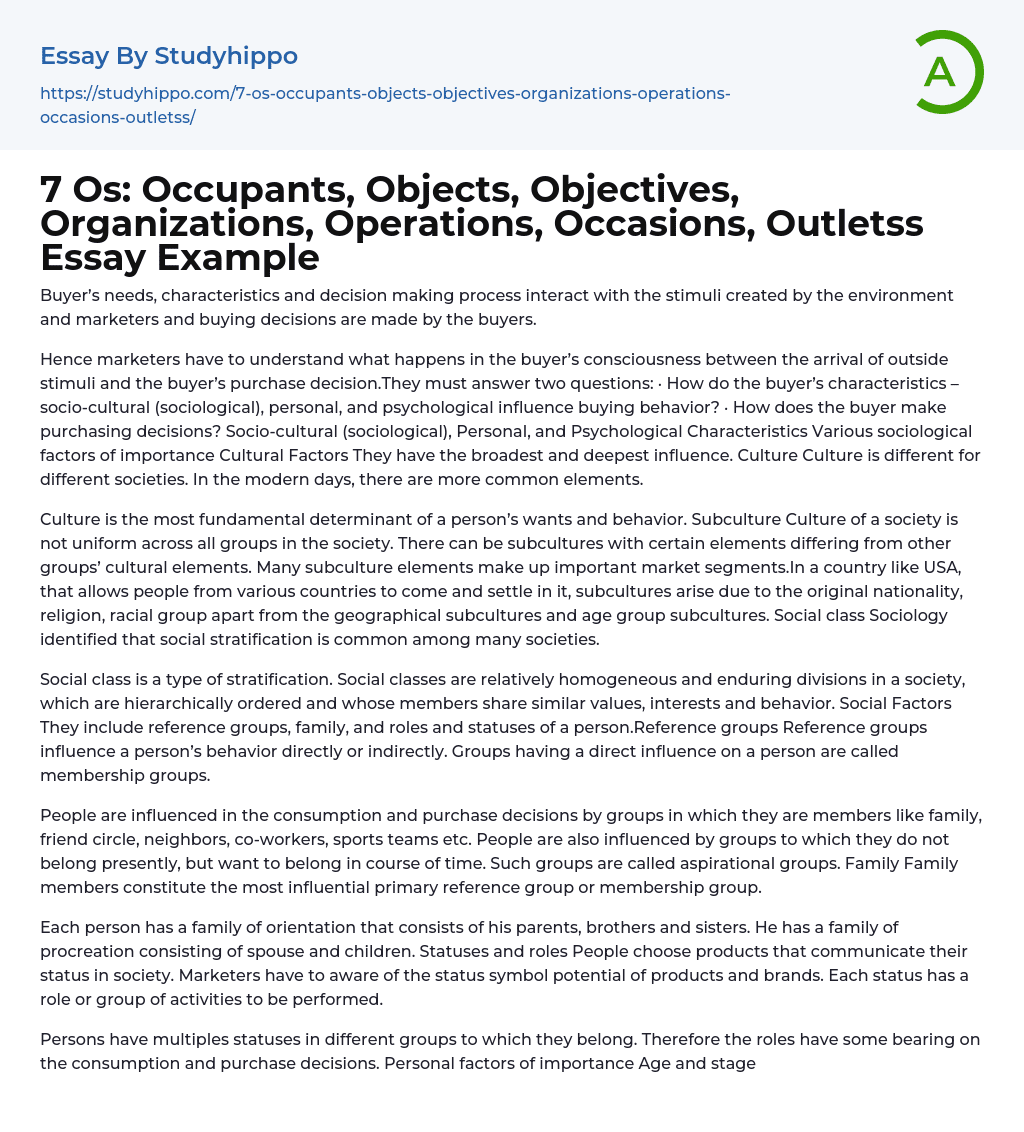

7 Os: Occupants, Objects, Objectives, Organizations, Operations, Occasions, Outletss Essay Example
Buyer’s needs, characteristics and decision making process interact with the stimuli created by the environment and marketers and buying decisions are made by the buyers.
Hence marketers have to understand what happens in the buyer’s consciousness between the arrival of outside stimuli and the buyer’s purchase decision.They must answer two questions: · How do the buyer’s characteristics – socio-cultural (sociological), personal, and psychological influence buying behavior? · How does the buyer make purchasing decisions? Socio-cultural (sociological), Personal, and Psychological Characteristics Various sociological factors of importance Cultural Factors They have the broadest and deepest influence. Culture Culture is different for different societies. In the modern days, there are more common elements.
Culture is the most fundamental determinant of a person’s wants and behavior. Subculture Culture of a society is not uniform across all groups in the soci
...ety. There can be subcultures with certain elements differing from other groups’ cultural elements. Many subculture elements make up important market segments.In a country like USA, that allows people from various countries to come and settle in it, subcultures arise due to the original nationality, religion, racial group apart from the geographical subcultures and age group subcultures. Social class Sociology identified that social stratification is common among many societies.
Social class is a type of stratification. Social classes are relatively homogeneous and enduring divisions in a society, which are hierarchically ordered and whose members share similar values, interests and behavior. Social Factors They include reference groups, family, and roles and statuses of a person.Reference groups Reference groups influence a person’s behavior directly or indirectly. Groups having a direct influence on a person are called membership groups.
People are influenced in th
consumption and purchase decisions by groups in which they are members like family, friend circle, neighbors, co-workers, sports teams etc. People are also influenced by groups to which they do not belong presently, but want to belong in course of time. Such groups are called aspirational groups. Family Family members constitute the most influential primary reference group or membership group.
Each person has a family of orientation that consists of his parents, brothers and sisters. He has a family of procreation consisting of spouse and children. Statuses and roles People choose products that communicate their status in society. Marketers have to aware of the status symbol potential of products and brands. Each status has a role or group of activities to be performed.
Persons have multiples statuses in different groups to which they belong. Therefore the roles have some bearing on the consumption and purchase decisions. Personal factors of importance Age and stage in the life cycle Children consume baby food.Old people may eat special diets.
People diagnosed with specific ailments avoid certain food items. Hence it is easy to conclude thaat people buy different goods and services over their life time. Occupation Occupation determines the types of items people buy. Certain occupations demand simple living and certain occupations demand display of wealth and prosperity. Economic circumstances People’s economic circumstances consist of their disposable or spendable income, assets, debts, and attitude toward spending versus saving.
Marketing of income-sensitive goods has to take into consideration the shifts in personal income and savings habits.Life style A person’s life style is the person’s pattern of living in the world as expressed in activities, interests, and opinions. People coming from
the same subculture, social class, and occupation do lead quite different life styles. The life style is reflected in the consumption patterns. different agencies and authors have identified differnet life style categories. McCann Erickson London identifed among British, Avant-Gardians, Pontificators, Chamelons and Sleepwalkers.
The advertising agency, D'arcy, Masius, Benton ; Bowles identified five categories among Russians, Kuptsi, Cossacks, Students, Business Executives, and Russian Souls.Llifestyles among British people. Avant-Gardians (interested in change) Pontificators (traditionalists, very British) Chamelons (follow the crowd) Sleepwalkers (contented underachievers) Psychological factors of importance Personality and self concept Personality denotes a person’s distinguishing psychological characteristics that lead to relatively consistent and enduring responses to various stimuli. Motivation Motivation to purchase and consume an item is to be understood by marketers.
Need sets up drive that seeks a goal. Marketers want the goal a person desires has to be the product that they are offering.A drive is a strong internal stimulus impelling action. Perception Perception is the process by which an individual selects, organizes, and interprets information inputs to create a meaningful picture of the world. Learning Learning involves changes in an individual’s behavior arising from experience.
Most human behavior is learned Beliefs and attitudes A belief is a descriptive thought a person holds about something. An attitude is a person’s enduring favorable or unfavorable emotional feelings and action tendencies toward some object or an idea.
- Perseverance essays
- Expressive essays
- Character Traits essays
- Apology essays
- Compassion essays
- Advertising essays
- Audience Theory essays
- Competitor Analysis essays
- Consumer essays
- Marketing Management essays
- Marketing Mix essays
- Marketing Plan essays
- Marketing Research essays
- Marketing Strategy essays
- Point Of Sale essays
- Price essays
- Procurement essays
- Product essays
- Product Differentiation essays
- Promotion essays
- Promotion And Marketing Communications essays
- Retailing essays
- Trademark essays
- Anheuser-busch essays
- Brands essays
- Detergent essays
- Product Placement essays
- Research Design essays
- New Product Development essays
- Advertisement essays
- Brand essays
- Sales Promotion essays
- Advertising campaign essays
- Consumer behaviour essays
- Offer And Acceptance essays
- Wal-Mart essays
- Discover essays
- Society essays
- Stereotypes essays
- Social Change essays
- Sociological Perspective essays
- Social Movement essays
- Charity essays
- Social Science essays
- Anthropology essays
- Generation essays
- Social Status essays
- Social Stratification essays
- Emile Durkheim essays
- Sociological Imagination essays



